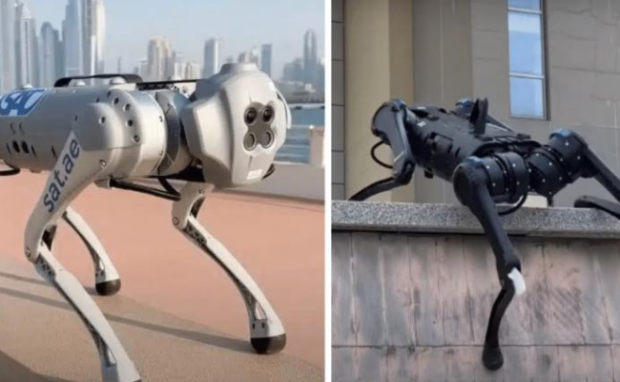AI algorithm teaches old robodogs new tricks
Do you have a robodog and wish it could do more stunts like parkour? Stanford University and Shanghai Qi Zhi Institute created an AI algorithm enabling robot canines to jump over obstacles and squeeze through tight spaces. Unlike Boston Robotics and similar machines, the researchers proved you can install it into “off-the-shelf robots.”
The latest technologies should benefit humanity, so they must be accessible to all. Case in point, robot dogs have the potential to become unique pets or aid in search and rescue operations. However, only a few can afford existing models. The latest AI algorithm might allow folks to create more budget-friendly options, letting everyone benefit.
This article will discuss how Stanford and Shanghai Qi Zhi’s algorithm improved robot canines. Then, I will explain how they created this AI robodogs algorithm.
How did the AI robodogs improve?
The Stanford and Shanghai Qi Zhi researchers installed their latest AI algorithm into “low-cost, off-the-shelf robots.” Then, they published their peer-reviewed findings on OpenReview.
“The autonomy and range of complex skills that our quadruped robot learned is quite impressive,” said the study’s senior author, Chelsea Finn. “And we have created it using low-cost, off-the-shelf robots – actually, two different off-the-shelf robots.”
Science update website PopSci says these machines were roughly 10 inches tall. Yet, they scaled objects up to 15.75 inches high, which is 1.53 times their height.
The AI robodogs lept over gaps 23.6 inches wide, 1.5 times their length. Moreover, they crawled beneath barriers 7.9 inches low, roughly a third of their height.
You may also like: The 6 best mouse pads
The new algorithm also enabled them to tilt to squeeze through spaces a fraction of an inch narrower than their width. More importantly, Stanford News says the team’s most significant breakthrough is enabling robot canines to act autonomously.
The AI robodogs used their onboard computers and cameras to perform these amazing feats. That means they didn’t need a human manipulating them via remote control.
“What we’re doing is combining both perception and control, using images from a depth camera mounted on the robot and machine learning to process all those inputs and move the legs in order to get over, under, and around obstacles,” said Zipeng Fu, a doctoral candidate in Finn’s lab.
How did the researchers train AI robodogs?

Photo Credit: bnn.network
Stanford and Shanghai Qi Zhi scientists created an AI algorithm installable into existing, low-cost robot canines. As a result, they have a significant advantage over Boston Dynamics bots.
The Massachusetts-based company has demonstrated its four-legged machines performing similar stunts. However, they required resources unavailable to most.
“The massive engineering efforts needed for modeling the robot and its surrounding environments for predictive control and the high hardware cost prevent people from reproducing parkour behaviors given a reasonable budget,” the research paper said.
PopSci said the experts trained their parkour algorithm by two reinforcement learning methods: soft and hard dynamics. Soft dynamics represented the AI robodogs as virtual robots, allowing them to penetrate and collide with simulated objects.
You may also like: Designer creates ‘Third Eye’ for ‘smartphone zombies’
The researchers used a simple reward mechanism to clear obstacles while avoiding collisions and minimizing effort. More importantly, they did not give instructions to the virtual robots.
They had to determine how to progress with trial and error. Next, the hard dynamics involved the same instructions and reward structure, but the bots must not collide with obstacles.
“It’s actually fairly simple,” Finn said. “We based it mostly on how far forward the robot is moving and the amount of effort it has applied to do it. Eventually, the robot learns more complex motor skills that allow it to get ahead.”
Conclusion
Shanghai Qi Zhi Institute and Stanford University created an AI algorithm that enabled market robodogs to perform parkour. The bots learned through trial and error, enabling them to hurdle obstacles without human intervention.
Further research and development could prepare the algorithm for practical applications. As a result, more countries may have AI robodogs for various purposes.
Gain more information about this research by reading the Robot Parkout Learning paper. Learn more about the latest digital tips and trends at Inquirer Tech.